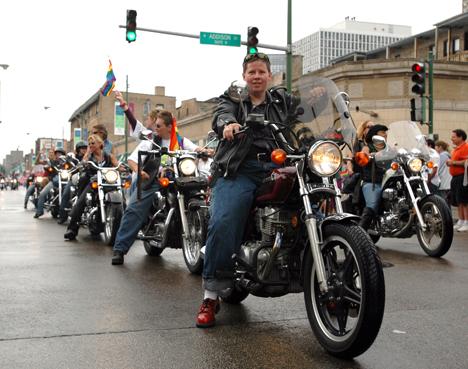Marching for ‘pride, not prejudice’
June 27, 2006
The sidewalks of Broadway Street were filled with spectators spilling over onto the streets. With signs reading “People for Free Illinois,” the crowd had to be routinely pushed back by police officers on All-Terrain-Vehicles. The massive crowd’s excitement grew when the Righteously Outrageous Twirling Corps performed their routine in full faux military uniform. This celebratory and explosive energy continued throughout Chicago’s annual Pride Parade.
Possibly the loudest performance was that of the Dykes on Bikes who ripped and roared their Harley Davidsons showing off their powerful motorcycles and received equally deafening cheers from the crowd.
“We’re not only one community, we are many different communities,” said Richard Pfeiffer, the Pride Parade Coordinator of Chicago.
Pfeiffer, 57, has been working on the Pride Parade since the seventies, dating back to the second Chicago Gay Pride Parade.
Hundreds of thousands of volunteers, spectators, and social activists gathered in Chicago Sunday afternoon for the 2006 Pride Parade which started at Halsted Street and Belmont Avenue, marched throughout the city, and ended in Lincoln Park.
Get The Daily Illini in your inbox!
“The parade has both social and political implications,” said Pfeiffer, referring to the several political groups who join-in on the festivities of the parade.
State Comptroller Daniel Hynes, and City Treasurer Judy Rice marched in the parade along with Aldermen, Manny Flores (1st ward), Tom Tunney (44th ward), and Helen Shiller (46th ward), making their presence known with banners and flags. Several other political officials were present in cars covered in rainbow flags.
Jill Schwartz, 22 of Buffalo Grove, said that it’s great that politicians show their support of the gay community, “as long as they are willing to speak up to ensure equality long after they step off the float.”
Star Trek star and gay actor/activist George Sakei was the parade’s Grand Marshal.
This year’s theme, “Pride not Prejudice” comes at a time of gay marriage debate in Congress. A constitutional amendment to ban gay marriage failed to pass.
“There is this feeling in the gay community that gay people should be allowed to civil marriage,” Pfeiffer said. “Gay people, just like everyone else, are taxpayers.”
Pfeiffer also said that the intention of the Pride Parade was not necessarily to combat the ban on gay marriage but to rejoice in gay pride itself, stating that the event is not necessarily a “march,” but a celebration.
Several University students made the trek up to Chicago to watch the parade and celebrate. “Happy Pride,” was a very common greeting heard within the group of University alumni and students.
Kory Heitzig, senior in FAA, got up at 6:30 a.m. Sunday morning in Champaign, to drive up to Chicago in hopes of making it in time for the pre-parade festivities.
“It is neat to see such a large gathering of talent. I am so surprised to see such specialized interest by the gay community,” said Heitzig about the parade’s diverse festivities.
An extensive array of gay communities rode on floats or walked while caring pride flags down the almost five hour long parade. Communities such as Parents and Friends of Gay, Lesbian, Bisexual, and Transgender; Chicago Gender Society; Lambda Legal; Chicago Gay Men’s Chorus; Amigas Latinas; Rainbow Alliance of the Deaf; and the Pride Youth Group showed their presence with colorful floats and music.
This extremely eclectic group of progressive communities, social organizations, political figures, celebrities, and spectators represents what Pfeiffer was hoping for.
“Rich or poor, young or old, black, white, brown, gay, lesbian, bisexual, transgender, even our allies, our friends who are not gay march with us,” Pfeiffer said. “We are married, we are single, we’re religious, we’re atheists, we have children, you can talk about any group in society and we represent that.”







